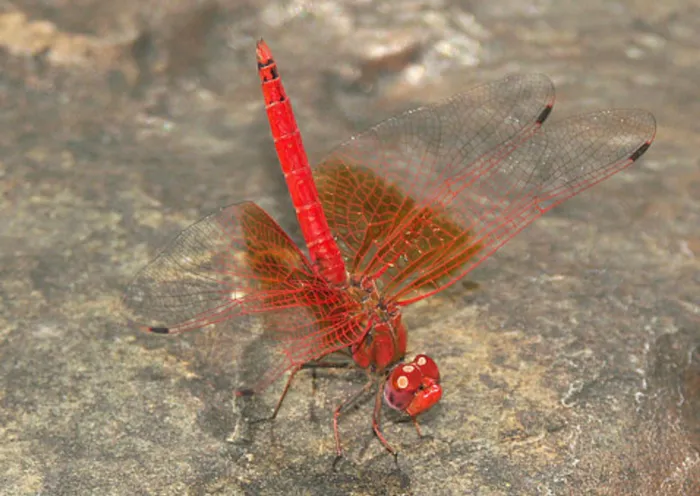Dazzle with dragonflies

ON The fly: The dramatic red Kirby's Dropwing. You can create a dragonfly paradise in your own garden " just don't add fish to their pond if you want these gorgeous creatures to stick around! ON The fly: The dramatic red Kirby's Dropwing. You can create a dragonfly paradise in your own garden " just don't add fish to their pond if you want these gorgeous creatures to stick around!
“Dragonflies are daring hunters, carnivorous, and fanatically territorial. They are also natural pest controllers, hovering over vegetation and lawns, feeding on insects such as whitefly, aphids and mosquitoes,” says indigenous gardening expert Gyll Mullins.
World-renowned entomologist and invertebrate conservationist Professor Michael Samways (University of Stellenbosch), and Christopher Willis, head of the SA National Biodiversity Institute’s (Sanbi) soon-to-be 11 national gardens, recently launched a book on dragonflies and damselflies.
The book is an illustrated checklist of 150 colour photographs of 61 (38 percent) of SA’s most commonly observed dragonflies and damselflies in Sanbi’s national botanic gardens. “This new book will assist tourists, teachers, learners and ‘citizen scientists’ wanting to know more about these beautiful creatures, and their place in SA’s unique natural heritage,” says Willis.
Sadly, the natural habitat of the dragonfly is under threat and it is feared that three SA species could be extinct.
Now is the time to create a dragonfly sanctuary in your garden.
To entice and nurture dragonflies, you need to provide a suitable home, protection and food. This means creating a pond, using unpolluted water, adding bog and fringe plants, as well as small rocks and pebbles, which provide for snug hiding holes for the dragonfly larvae. This abundance of plants and crevices creates what is known as “structural complexity”.
Follow Samway’s advice for building a dragonfly-friendly pond in your garden:
In a sunny area of the garden, dig an area at least the size of a tablecloth to a depth of about 450mm (not more than 1m). Aim for a shallow pond with a permanent water level.
Next, smooth the floor and sides – sloping sides are ideal.
Over the floor, lay a sheet of pond liner (plastic) and cover with a layer of coarse river sand and then a light sprinkling of well rotted leaves.
Plant up this underwater garden. Insert the roots of the plants firmly. Ensure that only about half the area of the pond is covered with greenery, and remember that the more varied the greenery the better.
You may like to try a form of underwater container gardening using clay pots and wire baskets to house the plants.
Choose indigenous plants and include emergent vegetation from the papyrus and sedge families.
Spread a good layer of pebbles or gravel and place some larger stones at the bottom to form underground “caves” for dragonfly larvae.
Then add water, gently, to avoid destabilising the layout. Tap water is fine, but if you’re uneasy about chlorination, let it stand for 24 hours before use. Keep in mind that it is vital to keep the pond topped up and the water level constant.
Dragonflies lay their eggs in water, thus it is essential to have a permanent water body if you wish dragonflies to inhabit your garden.
Some species prefer flowing water such as a gentle river or fountain, whereas other species prefer still water such as a pond.
Avoid adding fish, as they will wipe out the dragonfly larvae.
After filling the pool, gently introduce floating plants such as indigenous water lilies (Nymphoides capensis). Dragonflies love perching on the lily pads.
It is important to include submerged floating aquatics from the pondweed family (Potamogeton spp) to aerate the water.
Fringing plants play an important role in the habitat dragonflies choose to live in. Dragonflies generally like tall reeds, so it is ideal if you have reeds around your body of water, however any tall shrubs or plants are better than none. Dragonflies like to perch quietly on overhanging stems, so some plant life is essential.
Now you can plant up the surrounds. Include lots of local indigenous reeds, and also consider planting trailing sedge (Isolepis prolifer), moss fern (Selaginella kraussiana), an indigenous ground cover and kingfisher daisy (Felicia amelloides) in semi-shade for colour.
Add clumps of white arums, bullrushes (Typha capensis), wild iris (Dietes spp), red-hot pokers (Kniphofia spp) or wild tibouchina (Dissotis princeps).
Aerating plants sweeten the water, so a pump is not necessary. Indeed, the less disturbance the better. This is not an ornamental pond with sparkling water – if you start cleaning operations, you’ll clean the dragonflies away. Bear in mind that chemical pesticides do not belong in a dragonfly garden and will decimate these elegant creatures.
Be aware that due to the male’s territorial demands, the smaller the pond, the fewer species of dragonfly it will support. There is, however, a smaller, more delicate dragonfly called the damselfly that demands far less territory and may, hopefully, be attracted to your pond.
Due to their small antennae, dragonflies cannot smell or hear.
As a result they have compensated by having enormous eyes that have keen eyesight. They are constantly on the lookout and as a result, even the slightest movement in their surroundings will cause them to dart about nervously.
Once established, the most likely species to be drawn to your garden pond include: Swamp Bluet, Friendly Hawker, Blue Emperor, Orange Emperor, Whitelined Skimmer, Broad Scarlet, Red-veined Dropwing, Red-veined Darter, Lakeside Dropwing, Jaunty Dropwing and Wandering Glider.
Your pond will not only attract dragonflies, but creatures like water boatmen, backswimmers, diving beetles and harmless water scorpions. It could also be a magnet to frogs and benign garden snakes, altogether creating a balance between the hunters and the hunted.
* Water Dancers of South Africa’s National Botanical Gardens: An illustrated dragonfly and damselfly checklist. Compiled by Christopher Willis & Michael Samways. Sanbi, 2011, Pretoria - Saturday Star